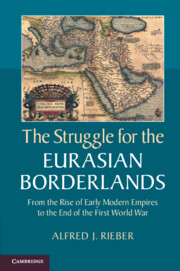 The Struggle for the Eurasian Borderlands
The Struggle for the Eurasian Borderlands Book contents
6 - Imperial legacies
Published online by Cambridge University Press: 05 June 2014
Summary
The wars and revolutions of the first two decades of the twentieth century that destroyed imperial rule have long been treated by historians as a series of ruptures in modern European history. Borderlands broke away from the imperial centers of power. Some followed the siren calls of national self-determination; elsewhere local warlords took regional control. The dynastic idea was dead or dying. The logic and structures of long-established internal markets and networks of transportation and communication were disrupted. The imperial armies disintegrated and their officer corps dispersed; in many cases former comrades-in-arms faced one another across disputed borders. New men, often from the margins of society or the military, rose to power, promoting new ideologies, or radical versions of the old. In the immediate postwar years, the peoples of the borderlands appeared to have taken their revenge for decades or centuries of imperial rule.
Placing too much emphasis on rupture, however, means running the risk of underestimating the legacies of imperial rule and ignoring the persistent factors that confronted the new ruling elites of the successor states. In this chapter historical legacy is employed to mean those elements of institutional, ideological, and cultural structures and practices that survived the demise of imperial rule. They show up most clearly in the nature of leadership and patterns of policy making, as well as in the policies themselves. Legacy in historical context is different from its legalistic meaning as something bequeathed to a successor without manifesting any alteration in its essential features. Historical change being what it is, legacy cannot be the literal equivalent of sameness. Burdened with legacies of imperial rule, the successors could not inscribe their solutions to the problems posed by persistent factors on a clean slate.
- Type
- Chapter
- Information
- The Struggle for the Eurasian BorderlandsFrom the Rise of Early Modern Empires to the End of the First World War, pp. 532 - 614Publisher: Cambridge University PressPrint publication year: 2014


